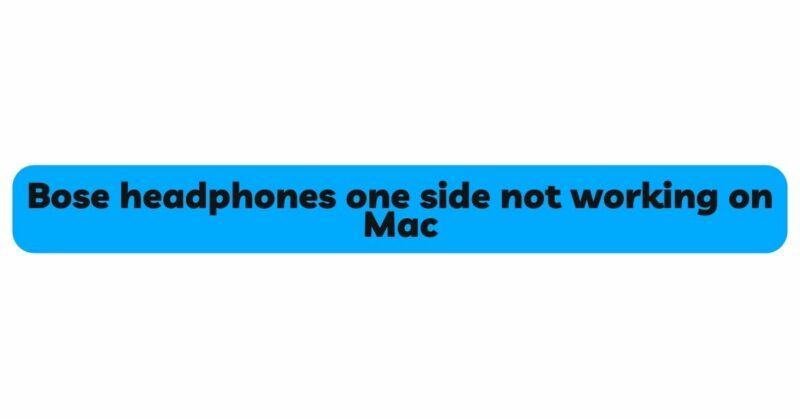Bose headphones are renowned for their superior audio quality and comfort, making them a popular choice among Mac users seeking an immersive sound experience. However, it can be frustrating to encounter a situation where one side of the headphones stops working on your Mac. This article aims to provide a detailed troubleshooting guide to help you identify and resolve the issue, ensuring you can continue to enjoy your Bose headphones to their fullest potential.
- Check Headphone Hardware
Before delving into software-related troubleshooting, it is essential to rule out any potential hardware issues with your Bose headphones. Follow these steps:
a. Inspect the headphone cable: Examine the cable thoroughly for any visible signs of damage, such as frayed wires or bent connectors. If you notice any issues, consider replacing the cable with a compatible one.
b. Verify headphone connections: Ensure that the headphone plug is firmly inserted into the Mac’s headphone jack. If you are using wireless Bose headphones, check that they are appropriately paired with your Mac.
c. Test the headphones on another device: Connect your Bose headphones to a different audio source to determine if the issue persists. If the problem is specific to your Mac, proceed with software troubleshooting.
- Check System Sound Settings
Misconfigured sound settings on your Mac can lead to audio issues with your headphones. To verify your Mac’s sound settings, follow these steps:
a. Click the Apple logo in the top-left corner of your Mac’s screen.
b. Select “System Preferences” from the drop-down menu.
c. In the System Preferences window, click on “Sound.”
d. Go to the “Output” tab and ensure that your Bose headphones are selected as the default audio output device.
e. Adjust the volume balance slider to the center position to ensure that both sides of the headphones are balanced.
f. Test the sound by playing audio or a video to see if the issue is resolved.
- Update Audio Drivers and Software
Outdated or corrupted audio drivers can cause compatibility issues between your Bose headphones and your Mac. To ensure your audio drivers are up-to-date, follow these steps:
a. Click the Apple logo and select “App Store” from the drop-down menu.
b. Click on the “Updates” tab to check for any available system updates, including audio-related drivers.
c. If updates are available, click “Update All” to install them.
d. Restart your Mac after the updates are installed.
- Reset NVRAM and SMC
Resetting the Non-Volatile Random-Access Memory (NVRAM) and the System Management Controller (SMC) can resolve various hardware-related issues on Mac computers, including audio problems with external devices like Bose headphones. To reset NVRAM and SMC, follow these steps:
a. Shut down your Mac.
b. Turn it on, and immediately press and hold the following keys for approximately 20 seconds: Option, Command, P, and R. Release the keys when you hear the startup sound twice.
c. After the Mac restarts, shut it down again.
d. Unplug the power adapter from your Mac (if applicable).
e. Press and hold the left Shift, Control, Option, and the power button simultaneously for around 10 seconds.
f. Release all the keys and reconnect the power adapter (if applicable).
g. Turn on your Mac and check if the issue with your Bose headphones is resolved.
- Check for Software Conflicts
Sometimes, third-party software or conflicting applications can interfere with your Mac’s audio output. To troubleshoot this:
a. Close all unnecessary applications running in the background.
b. Restart your Mac and check if the issue persists.
c. Try using your Bose headphones in Safe Mode, which prevents third-party software from loading. To enter Safe Mode, restart your Mac and hold down the Shift key until the Apple logo appears.
d. Test your headphones while in Safe Mode to see if the problem is resolved.
- Reset Audio Preferences
Resetting audio preferences can often solve audio-related issues on a Mac. To do this:
a. Go to the Finder on your Mac.
b. Press and hold the Option key while clicking the “Go” menu in the top menu bar.
c. Click on “Library” to access the Library folder.
d. Navigate to the folder: Library > Preferences.
e. Locate the files named “com.apple.audio.DeviceSettings.plist” and “com.apple.audio.SystemSettings.plist.”
f. Move these files to the Trash or another location on your computer (you may need to enter your admin password).
g. Restart your Mac.
h. Test your Bose headphones to check if the problem is resolved.
- Update macOS
Ensure that your Mac is running the latest version of macOS. Software updates can address compatibility issues and bug fixes that might be affecting the audio output. To update macOS:
a. Click the Apple logo and select “System Preferences.”
b. Click on “Software Update” to check for available updates.
c. If updates are available, click “Update Now” to install them.
d. Restart your Mac after the update is complete.
Conclusion
Encountering a situation where one side of your Bose headphones isn’t working on your Mac can be frustrating, but there are various troubleshooting steps you can take to identify and resolve the issue. By checking headphone hardware, verifying system sound settings, updating audio drivers and software, and resetting NVRAM and SMC, you can address many common audio-related problems. Additionally, checking for software conflicts, resetting audio preferences, and updating macOS can further contribute to a seamless and balanced audio experience with your Bose headphones on your Mac. Remember that each troubleshooting step should be performed carefully, and if the problem persists, seeking assistance from Bose customer support or Apple’s support team may be necessary to diagnose and resolve more complex issues.


